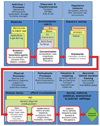Chlorpyrifos and neurodevelopmental effects: a literature review and expert elicitation on research and policy
- PMID: 22759505
- PMCID: PMC3388448
- DOI: 10.1186/1476-069X-11-S1-S5
Chlorpyrifos and neurodevelopmental effects: a literature review and expert elicitation on research and policy
Abstract
Background: Organophosphate pesticides are widely used on food crops grown in the EU. While they have been banned from indoor use in the US for a decade due to adverse health effects, they are still the most prevalent pesticides in the EU, with Chlorpyrifos (CPF) being the most commonly applied. It has been suggested CPF affects neurodevelopment even at levels below toxicity guidelines. Younger individuals may be more susceptible than adults due to biological factors and exposure settings.
Methods: A literature review was undertaken to assess the evidence for CPF contributing to neurodevelopmental disorders in infants and children. Other literature was consulted in order to formulate a causal chain diagram showing the origins, uptake, and neurological effects of animal and human exposure to CPF.The causal chain diagram and a questionnaire were distributed online to scientific experts who had published in relevant areas of research. They were asked to assess their confidence levels on whether CPF does in fact contribute to adverse neurodevelopment outcomes and rate their confidence in the scientific evidence. A second questionnaire queried experts as to which kind of policy action they consider justifiable based on current knowledge. In a special workshop session at the EuroTox congress in Dresden in 2009 the results of both questionnaires were further discussed with invited experts, as a basis for a policy brief with main messages for policy makers and stakeholders.
Results: Most experts who responded to the first questionnaire felt that there was already enough evidence to support a ban on indoor uses of CPF in the EU. However, most felt additional research is still required in several areas. The responses from the first questionnaire were used to formulate the second questionnaire addressing the feasibility of government action. In turn, these expert participants were invited to attend a special session at the EuroTox congress in Dresden in 2009.
Conclusions: Some of the evidence that CPF contributes to neurodevelopmental disorders is still disputed among experts, and the overall sense is that further research and public awareness are warranted. There have been campaigns in North America making the potential exposure concerns known, but such information is not widely known in the EU. The ability of government action to produce change is strongly felt in some quarters while others believe better knowledge of consumer use trends would have a greater impact.
Figures




References
-
- Van den Hazel P, Zuurbier M. PINCHE project: Final report WP1 exposure assessment. Arnhem, Netherlands: Public Health Services Gelderland Midden; 2005.
-
- Morgan MK, Sheldon LS, Croghan CW, Jones PA, Robertson GL, Chuang JC, Wilson NK, Lyu CW. Exposures of preschool children to chlorpyrifos and its degradation product 3,5,6-trichloro-2-pyridinol in their everyday environments. J Expo Anal Environ Epidemiol. 2005;15(4):297–309. doi: 10.1038/sj.jea.7500406. - DOI - PubMed
-
- Becker K, Seiwert M, Angerer J, Kolossa-Gehring M, Hoppe HW, Ball M, Schulz C, Thumulla J, Seifert B. GerES IV pilot study: assessment of the exposure of German children to organophosphorus and pyrethroid pesticides. Int J Hyg Environ Health. 2006;209(3):221–233. doi: 10.1016/j.ijheh.2005.12.002. - DOI - PubMed
Publication types
MeSH terms
Substances
LinkOut - more resources
Full Text Sources

